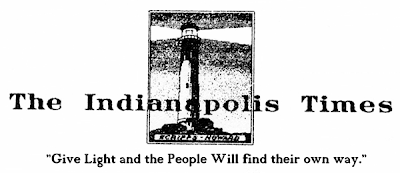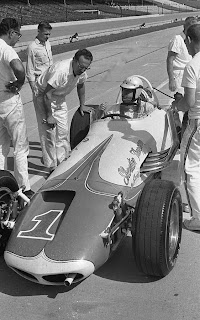
The following article was published in the May 30, 1958 “Race Edition” of the Indianapolis Star.
The story has no byline, but I’m fairly certain my father, Rick Johnson, wrote it due to phrasing and word usage, which seem to reflect his style. I can almost hear him speak the story….
The story is a good one, and very interesting, so I figured I’d post it here.
Seeing as I’m not 100% sure Dad wrote it, I figure if I give a nice, warm and fuzzy blanket credit, I won’t get my ass sued off!
Therefore, I will credit this story to the Indianapolis Star and their Sports Department as a whole, as oftentimes more than one writer would contribute to a piece…Jep Cadou. Jr., (Star Sports Editor), Bob Collins, Al Roche, Bill Eggert (father of a guy I went to High School with), William H. Keenan, Fred D. Cavinder, and one of my dad’s bestest pals at the Indianapolis Star, Carolyn Pickering.
Sincerely,
Paul A. Johnson
Road Racing Champ Wouldn’t Try The ‘500’ Spin
Juan Said ‘Adios’ To Indianapolis
 (Indianapolis Star Photo)
(Indianapolis Star Photo)Maybe a prize from a millionaire sportsman will overcome the jinx that has dogged the glamour racers from other lands at the Indianapolis merry-go-round.
This year it was Juan Fangio. Last year it was Nino Farina.
Both men are veterans of the muscle-gripping, nerve-rending grinds of road racing. They have mastered courses that might have twisted seasoned 500-milers like ribbons…the rugged mountain roads of South America and the tricky, gyrating trails of Italy, France, and Germany.
Monte Nero, Masarjk of Czechoslovakia, Modena, Grand Prix de Tunisia, Monaco, Anversa, Rouen, d’Eifel and Buenos Aires and Mille Miglia are tough test of man and machine.
Drivers who have weathered them deserve the royal speed title.
But Indianapolis has been the Waterloo of more than one of the mighty Latin aces.
The 46-year old Fangio had long before this year expressed ambitions to try his luck in the Indianapolis “500.” A year ago they were saying he had probably given it up.
Indianapolis stands out as a final goal to conquer after the road racers have marked up their scores of greatness.
One American racing tycoon, Floyd Clymer of California, decided to lure Juan Manuel Fangio to Indianapolis with a dare and a money challenge. That was almost a year ago.
Clymer put up $6,500…$500 to be paid the day Fangio’s entry for the 1958 race was accepted by the Indianapolis Motor Speedway, $1,000 on the day he qualified. Clymer put it crustily, saying, “I’m not convinced you can even qualify.”
He offered the Argentine ace $2,500 if he finished better than fifth in a United States-built car, or $5,000 if Fangio finished better than fifth in any foreign-built car.
Fangio, possibly feeling his oats because he whipped his Maserati around the Reims course for a new lap average of 145 miles during a trial for the Grand Prix there, said he would study the American offer with “greatest sympathy.”
Clymer’s dare stemmed from the refusal of Fangio and other top European drivers to compete against U.S. drivers in the June, 1957 race at Monza, Italy.
The Europeans explained their move by saying they felt Monza was better suited to American closed-circuit racing cars than to European sports cars, which are built for road racing.
Jimmy Bryan, of Phoenix, who placed second in the 1957 “500,” won on the high-banked track at Monza with an average speed of nearly 160 miles an hour.
Fangio said, “My desire to participate at Indianapolis is an aspiration which I have had for a long time.”
A month later, he was saying he was most anxious to race in the “500” if he was offered a suitable car. Some Yankees were questioning Fangio’s title to the “world championship,” in view of the fact that he’d never made it at Indy.
Then the jinx showed. Late in September, Juan’s car tangled with a heavy truck in Italy on the road to Modena. His wrist went into a cast and he had to stay on the bench and miss the Grand Prix di Modena.
In March, he came to the U.S.A. for the 12-hour endurance spin at Sebring, Fla., but decided not to run. Perhaps the jinx had given him another turn when he was kidnapped in February by Cuban rebels. But he didn’t seem the worse for wear.
Meanwhile, he seemed to have changed his mind about Indianapolis, saying definitely, “No.”
By April he had changed his mind and was saying he wanted to get the “feel” of the Indy-style cars. He tried a “500” machine for size.
Juan Manuel Fangio arrived in Indianapolis May 1 and sailed through his Speedway physical. He seemed fairly confident and vowed he would give Clymer’s dare-money to charity.

He almost copped it on the track May 4 in a spin and a tangle with Ray Crawford’s car, but it was one of those lucky moments and no one was hurt.

 (Indianapolis Star Photo)
(Indianapolis Star Photo)On May 8 he passed his driver’s test. There was talk he would pilot the Novi, and then the Dayton Steel Foundry Car.

Then on May 15 he begged out, explaining through a spokesman that “the car is not in the optimum condition to permit Mr. Fangio to uphold his reputation as a world champion race driver.” There were also “unexpected complications” involving his fuel contract.
The winner of five world’s Grand Prix titles had done well at Indy, grinding up to the 142-miles-an-hour mark in trials, but he explained there were things about the closed circuit he didn’t exactly dig. For instance, when a car spun it stayed on the track in front of you. In a road race, it would slide off the course.
Fangio had proved he could drive a car on the world’s toughest track.
There were few snarls. He had cozied with death often.
You can be a brave bullfighter without being a channel swimmer, great lover, or polo star. It would be nice to live many lives, but no one will strip you of your medals if you do a first-rate job of living one.
Thus, Juan Fangio said “Adios,” and the “500” kept its all-USA makeup.
It was not always so. Some of the fieriest hours of the “500” owe to foreign cars and drivers.
French Peugeots won in 1913, 1916, and 1919, and came in second in 1914 and 1915. An Italian Fiat made second place in 1911 and third in 1914.
Foreign cars ranked among the top ten in may races.
Before the first World War and during the years between the wars, the brickyard was known around the world as the world’s ultimate challenge of men and machines.
It still is.














































